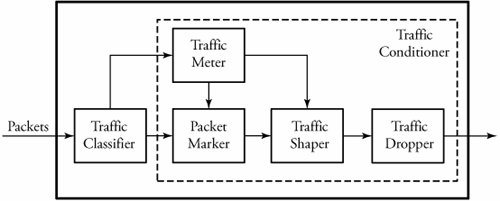Section 12.3. Differentiated Services QoS
12.3. Differentiated Services QoSThe differentiated services (DS), or DiffServ, approach provides a simpler and more scalable QoS. DS minimizes the amount of storage needed in a router by processing traffic flows in an aggregate manner, moving all the complex procedures from the core to the edge of the network. A traffic conditioner is one of the main features of a DiffServ node to protect the DiffServ domain. As shown in Figure 12.14, the traffic conditioner includes four major components : meter, marker, shaper, and dropper. A meter measures the traffic to make sure that packets do not exceed their traffic profiles. A marker marks or unmarks packets in order to keep track of their situations in the DS node. A shaper delays any packet that is not compliant with the traffic profile. Finally, a dropper discards any packet that violates its traffic profile. Figure 12.14. Overview of DiffServ operation When users request a certain type of service, a service provider must satisfy the user 's need. In order to allocate and control the available bandwidth within the DS domain, a bandwidth broker is needed to manage the traffic. The bandwidth broker operates in its own DS domain and maintains contact with other bandwidth brokers at neighboring domains. This is a way to confirm that a packet's requested service is valid throughout all domains within the routing path of the packet. In order to process traffic flows in an aggregate manner, a packet must go through a service-level agreement (SLA) that includes a traffic-conditioning agreement (TCA). An SLA indicates the type of forwarding service, and a TCA presents all the detailed parameters that a customer receives. An SLA can be either static or dynamic. A static SLA is a long- term agreement, and a dynamic SLA uses the bandwidth broker that allows users to make changes more frequently. A user preferring packet-dependent quality-of-service can simply mark different values in the type of service (ToS) field at either the host or its access router. Routers in the DS model then detect the value in the DS field in per hop behaviors (PHBs). The quality-of-service can then be performed in accordance with the PHB. In order to establish a traffic-policing scheme, a service provider uses a traffic classifier and a traffic conditioner at the domain's edge router when packets enter the service provider's network. The traffic classifier routes packets to specific outputs, based on the values found inside multiple fields of a packet header. The traffic conditioner detects and responds if any packet has violated any of the rules specified in the TCA. The DiffServ field value is set at the network boundaries. A DiffServ router uses the traffic classifier to select packets and then uses buffer management and a scheduling mechanism to deliver the specific PHB. The 8-bit DiffServ field is intended to replace the IPv4 ToS field and the IPv6 traffic class field. Six bits are used as a differentiated services code point (DSCP) to specify its PHB. The last 2 bits are unused and are ignored by the DS node. 12.3.1. Per-Hop Behavior (PHB)We define two PHBs: expedited forwarding and assured forwarding . As for DiffServ domains, the expedited forwarding PHB provides low-loss, low-latency, low-jitter, ensured-bandwidth, and end-to-end services. Low latency and ensured bandwidth can be provided with a few configurations on the DiffServ node. Both the aggregate arrival rate for expedited-forwarding PHB packets and the aggregate arrival rate should be less than the aggregate minimum departure rate. Several types of queue-scheduling mechanisms may be used to implement expedited-forwarding PHB. Ensured-forwarding PHHB delivers packets with high assurance and high throughput, as long as the aggregate traffic does not exceed TCA. However, users are allowed to violate TCA, but the traffic beyond TCA is not given high assurance. Unlike the expedited forwarding PHB, the ensured-forwarding PHB does not provide low-latency and low-jitter application. The ensured forwarding PHB group can be classified into three service types: good, average, and poor. Three possible drop-precedence values are then assigned to packets within each class, determining the priority of the corresponding packet. |
EAN: 2147483647
Pages: 211